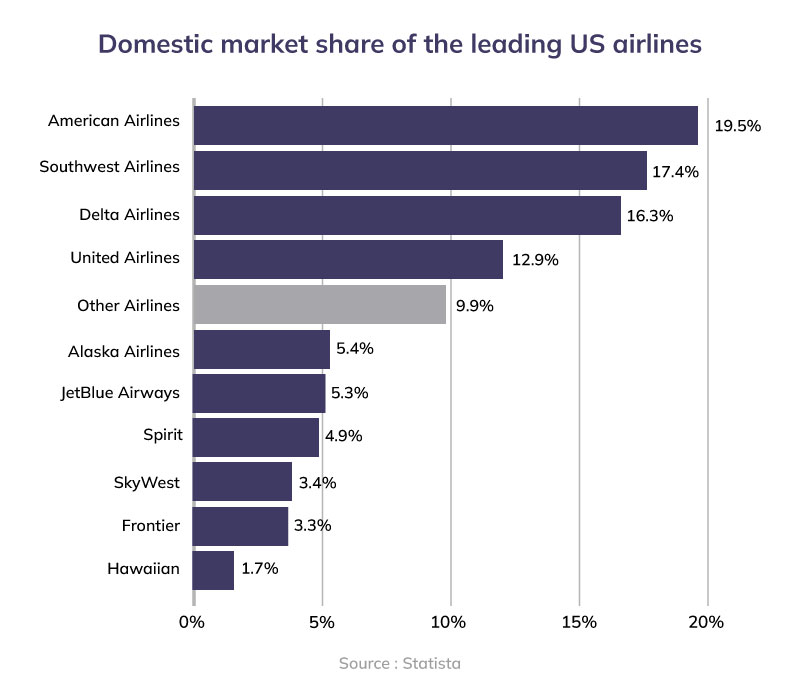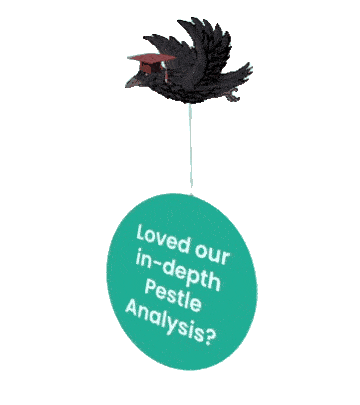Southwest Airlines Overview
Southwest Airlines is an American airline that flies to 47 states of the US along with 10 other countries. The company has a huge network and operates across 121 airports (Southwest, 2021). The airline plays has a significant 17.4% market share in the US aviation industry. The company has 56,500 full-time employees and earned $15.8 billion in revenues in 2021 which was an increase of 74.5% over 2020.
Furthermore, Southwest Airlines’ vision is to be the world's most loved, most efficient, and most profitable airline. To fulfill its vision, the company offers the lowest prices of all the airlines on many high-frequency routes. It has been awarded the safest US airline with no accident for 50 years from 1968-to 2018 and in 2018 it suffered a minor accident wherein the engine exploded and 1 passenger died.
Probing further, the PESTLE Analysis is an effective tool for analyzing the external environment with respect to the industry. It reveals the political, economic, social, technological, environmental, and legal aspects prevalent in the countries.
This article would contain a depth analysis of the prevailing political, economic, social, technological, environmental, and legal environment for the aviation industry in the US with respect to Southwest Airlines. Let us get going with the PESTLE Analysis of Southwest Airlines.
An insightful PESTLE analysis of Southwest Airlines
Political factors affecting Southwest Airlines
The federal government of the US has launched the Aviation Manufacturing Jobs Protection Program wherein employers can avail 50% subsidy for the pay and benefits being granted to employees. This would ease the financial burden on airline companies (Internal Association of Machinists and Aerospace Workers, 2021). Further, the taxation system is favorable for the companies as the federal government recently reduced the corporate tax rate from 35% to 21% to boost investments and increase the amount of liquidity with the companies. The Federal Aviation of Administration has downgraded its ratings for Mexican Federal Aviation Administration and hence the US airlines have been prohibited from further codeshare with any Mexican airline (Josephs, 2021).
Economic factors affecting Southwest Airlines
The COVID had a significant impact on the operations of the aviation industry and initially, there was a 50% reduction in the air traffic while the emergence of the omicron variant last year led American airlines to the loss of $931 million in the Q42021. However, in spite of huge losses, the industry is recovering now with government support and a rise in both domestic and international traffic. In addition, the per capita income in 2021 was $63, 416 while it is expected to lower to $55000 in 2022 and $57000 in 2023. The high reduction in per capita income can impact the revenues of the companies.
Furthermore, the US airline industry is worth $130.85 billion and contributes 5.2% to the nation’s GDP. Moreover, the domestic market shares of US airlines are illustrated in the graph below.

Social factors affecting Southwest Airlines
In the US, the trend of vacations is on the rise after COVID among the people with 50% of people preferring to go on at least one vacation in the next six months. The preference for environment-friendly products is rising among US customers with 70% of people thinking that the brands should be environmentally sustainable in their operations. To adapt to the changing customer preference, airlines would need to look for alternate sustainable fuel options like fuel made from solid waste or agricultural residues. This can pose a financial and operational challenge for the companies as they would need to replace their fleet with more fuel-efficient planes.
Technological factors affecting Southwest Airlines
The US government spent $157 billion on research and development in 2021 and the expenditure for 2022 is estimated to be $171 billion.
Various technologies that have revolutionized the airline industry include the use of blockchain for managing the supply chain and 3D printing for manufacturing various parts of aircraft. Another technology includes the use of the Internet of Things for predicting potential damage to the airplane. Further, the manufacturers are experimenting with planes that are capable of running solely on hydrogen. This can help the airlines reduce the carbon emissions from their operations. Further, artificial intelligence can be used to track customer behavior and offer personalized services. Also, recognition tools ease the tasks related to customer data entry.
Legal factors affecting Southwest Airlines
The regulations that govern the aviation sector in the US include The Federal Aviation Act which enlists the standards for designing and constructing the plane along with setting standards for the materials that should be used (CaseyGarry, 2022). The Federal Aviation Act also contains the protocols and guidelines for air navigation and air traffic control and the federal aviation agency is responsible for enforcing these standards. Further, the government has formulated a rule wherein the airlines would have to refund the checked baggage fees if the baggage on domestic flights is delayed beyond 12 hours and 25 hours for international flights (US Department of Transportation, 2021). In addition, the airline companies that are heavily dependent on Max 737s can again face disruptions in operations because of the risk of ceasing of Max fleet as a result of the recent accident in China.
Environmental factors affecting Southwest Airlines
The aviation industry is responsible for about 3% of the total carbon emissions in the US and 9% of the greenhouse gas emissions from the transport sector. The US is a signatory to the Paris Accord and therefore has decided to reduce carbon emissions by 50% till 2030 to adhere to the agreements. This would increase the financial burden on the aviation companies as they would have to replace their fleet with more environment-friendly aircraft.
To wrap up, the aviation industry is going through a rough patch but it has the potential to stand up because of the subsidy being offered by the government, and also the trend of vacation has risen among the US residents. But, the thing that can be a challenge is the preference of the customers towards sustainable transportation because of which the aviation companies would have to shift to sustainable fuel options, and for this, they would need to overhaul their fleet which can be a costly affair. Moreover, if you wish to analyze the internal capabilities of the company, you can delve into an astute SWOT analysis of Southwest Airlines conducted by us with extensive research.
Recommended Readings
References
AMADEO, K. (2022). U.S. Economic Outlook for 2022 and Beyond. Retrieved 11 April 2022, from https://www.thebalance.com/us-economic-outlook-3305669
Casey Garry. (2018). Federal, State And International Aviation Laws: What You Need To Know. Retrieved 11 April 2022, from https://caseygerry.com/federal-state-and-international-aviation-laws-what-you-need-to-know/
CIEC. (2021). Mexico Household Income per Capita. Retrieved 11 April 2022, from https://www.ceicdata.com/en/indicator/mexico/annual-household-income-per-capita
US Department of Commerce. (2022). Gross Domestic Product, Fourth Quarter and Year 2021 (Advance Estimate). Retrieved 11 April 2022, from https://www.bea.gov/news/2022/gross-domestic-product-fourth-quarter-and-year-2021-advance-estimate
U.S. Department of Transportation. (2021). U.S. Department of Transportation Announces Proposed Rule to Require Airlines to Refund Fees to Consumers for Significantly Delayed Bags and Services Not Provided by the Airline. Retrieved 11 April 2022, from https://www.transportation.gov/briefing-room/us-department-transportation-announces-proposed-rule-require-airlines-refund-fees#:~:text=The%20NPRM%20announced%20today%20proposes,25%20hours%20for%20international%20flights

 Proof Reading
Proof Reading  Copy Writing
Copy Writing  Resume Writing
Resume Writing  Blogs
Blogs Guides
Guides SOP's
SOP's Student Resources
Student Resources Research Topics
Research Topics Login
Login Register
Register



